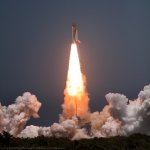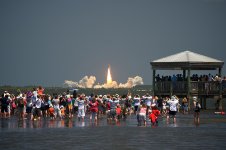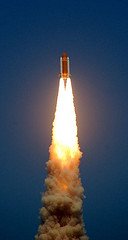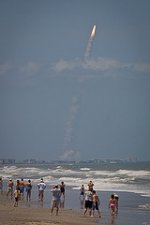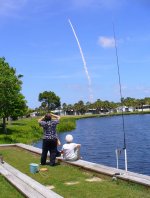David Baxter PhD
Late Founder
Strapping In With the Crew of the Shuttle for Launch Training
Strapping In With the Crew of the Shuttle for Launch Training
By Jason Paur, Wired
May 13, 2010
The STS-132 crew will buckle into the space shuttle Atlantis tomorrow before launching into orbit for a 12-day mission to the International Space Station. It is the last scheduled flight of Atlantis, and the last scheduled flight for each of the six astronauts aboard.
Earlier this month, I was at the Johnson Space Center after STS-132 commander Ken Ham invited me to join the crew on a launch-simulation training session. After spending some time in the fixed-base simulator practicing landings, Commander Ham thought it would be interesting for me to get a taste of the launch simulations in the full-motion simulator.
The motion-based simulator (MB) is similar to the full-motion simulators used to train airline pilots. There is a complete reproduction of the entire space shuttle cockpit, and screens out the windows replicate the scenery during flight. Unlike the full-motion simulators used by the airlines, the MB that trains the astronauts can tilt all the way back to simulate the launch position of the orbiter with everybody on board lying on their backs.
Inside the cockpit are Commander Ken Ham in left seat and Pilot Tony Antonelli in the right seat. Directly behind the right seat, sits Mission Specialist Garrett Reisman and, in the middle behind a center console, sits Mission Specialist Michael Good. During launch, mission specialists Piers Sellers and Steve Bowen will be in the mid-deck and did not take part in the cockpit training sessions. Though there are only four seats in the cockpit of the orbiter, there is a fifth seat in the simulator located directly behind Commander Ham?s seat for observers.
After everybody is strapped in, and all loose objects are secured, the entire cockpit is tilted on to its back and the crew sits waiting for the training to begin.
[video]http://link.brightcove.com/services/player/bcpid46203255001?bclid=46205328001&bctid=85466876001[/MEDIA]
There was no iconic countdown in the simulation. After confirmation over the headset with the launch crew at mission control that everything was secure and ready to go, we could hear the rumbling sound of rockets and the entire MB started to shake. The shaking is an attempt to recreate as much of the real launch conditions as possible. The full load of the sustained g forces can?t be replicated, but lying on your back with everything moving around provides some of the feeling of launch.
Inside the simulator, you can feel when the solid rocket boosters detach. The shaking stops once the main engine is cut off, about eight minutes and 30 seconds into the flight. By the time the shaking stops, the simulator is returned to a level position so the crew is no longer lying on their backs.
Over the course of several hours, the crew rehearsed several launch emergency scenarios, some of them stacked one after the other during a single session. After each session, the crew debrief with the trainers who are monitoring the training in a room nearby. Once the debrief was done, the MB was returned to the vertical position, a few small, loose items fall to the back of the cockpit and several minutes later, everything starts shaking and a new session begins.
From my vantage point in the extra fifth seat behind Commander Ham, watching the crew train is complete information overload. The crew remains calm through each emergency and works together like a well-oiled machine. And crew resource management takes on a whole new meaning with a four-person crew and several more on the ground at mission control. But the constant stream of information coming in from the ground crew over the headsets, the information presented inside the cockpit and the book-like checklists that are constantly referred to is incredible.
The mood during each session is all business. Each crew member is working very hard to find a solution to the wide range of emergencies that?s being thrown at him. But during the short breaks between sessions, it sounds more like your average office chit-chat. The crew talks about Little League games and past work experience, though since that includes previous missions to space and flying fighter jets, it?s not exactly mundane. There are plenty of jokes and laughter.
The various simulators used by the space shuttle crews are - practically speaking - the main way for astronauts to gain experience. Commander Ham and other members of the STS-132 crew have been been astronauts for more than a decade, but except for Piers Sellers, this will only be their second mission to space.
Unlike an airline or military pilot who can spend a decade gaining experience during actual flight training and missions, the relative lack of actual time in the orbiter means there is very little opportunity to gain ?on the job? experience for the astronauts. After spending only half a day in the MB watching the crew deal with everything from fires to aborted trips to orbit due to engine failures, it is apparent there is plenty of experience to be gained while only shaking 20 feet above the ground.
The crew will buckle into the real orbiter tomorrow morning. After thousands of training sessions in a variety of simulators, they are scheduled to lift off at 2:20pm EDT for a twelve day mission to the ISS. There are only three scheduled space shuttle missions remaining remaining.
Strapping In With the Crew of the Shuttle for Launch Training
By Jason Paur, Wired
May 13, 2010
The STS-132 crew will buckle into the space shuttle Atlantis tomorrow before launching into orbit for a 12-day mission to the International Space Station. It is the last scheduled flight of Atlantis, and the last scheduled flight for each of the six astronauts aboard.
Earlier this month, I was at the Johnson Space Center after STS-132 commander Ken Ham invited me to join the crew on a launch-simulation training session. After spending some time in the fixed-base simulator practicing landings, Commander Ham thought it would be interesting for me to get a taste of the launch simulations in the full-motion simulator.
The motion-based simulator (MB) is similar to the full-motion simulators used to train airline pilots. There is a complete reproduction of the entire space shuttle cockpit, and screens out the windows replicate the scenery during flight. Unlike the full-motion simulators used by the airlines, the MB that trains the astronauts can tilt all the way back to simulate the launch position of the orbiter with everybody on board lying on their backs.
Inside the cockpit are Commander Ken Ham in left seat and Pilot Tony Antonelli in the right seat. Directly behind the right seat, sits Mission Specialist Garrett Reisman and, in the middle behind a center console, sits Mission Specialist Michael Good. During launch, mission specialists Piers Sellers and Steve Bowen will be in the mid-deck and did not take part in the cockpit training sessions. Though there are only four seats in the cockpit of the orbiter, there is a fifth seat in the simulator located directly behind Commander Ham?s seat for observers.
After everybody is strapped in, and all loose objects are secured, the entire cockpit is tilted on to its back and the crew sits waiting for the training to begin.
[video]http://link.brightcove.com/services/player/bcpid46203255001?bclid=46205328001&bctid=85466876001[/MEDIA]
There was no iconic countdown in the simulation. After confirmation over the headset with the launch crew at mission control that everything was secure and ready to go, we could hear the rumbling sound of rockets and the entire MB started to shake. The shaking is an attempt to recreate as much of the real launch conditions as possible. The full load of the sustained g forces can?t be replicated, but lying on your back with everything moving around provides some of the feeling of launch.
Inside the simulator, you can feel when the solid rocket boosters detach. The shaking stops once the main engine is cut off, about eight minutes and 30 seconds into the flight. By the time the shaking stops, the simulator is returned to a level position so the crew is no longer lying on their backs.
Over the course of several hours, the crew rehearsed several launch emergency scenarios, some of them stacked one after the other during a single session. After each session, the crew debrief with the trainers who are monitoring the training in a room nearby. Once the debrief was done, the MB was returned to the vertical position, a few small, loose items fall to the back of the cockpit and several minutes later, everything starts shaking and a new session begins.
From my vantage point in the extra fifth seat behind Commander Ham, watching the crew train is complete information overload. The crew remains calm through each emergency and works together like a well-oiled machine. And crew resource management takes on a whole new meaning with a four-person crew and several more on the ground at mission control. But the constant stream of information coming in from the ground crew over the headsets, the information presented inside the cockpit and the book-like checklists that are constantly referred to is incredible.
The mood during each session is all business. Each crew member is working very hard to find a solution to the wide range of emergencies that?s being thrown at him. But during the short breaks between sessions, it sounds more like your average office chit-chat. The crew talks about Little League games and past work experience, though since that includes previous missions to space and flying fighter jets, it?s not exactly mundane. There are plenty of jokes and laughter.
The various simulators used by the space shuttle crews are - practically speaking - the main way for astronauts to gain experience. Commander Ham and other members of the STS-132 crew have been been astronauts for more than a decade, but except for Piers Sellers, this will only be their second mission to space.
Unlike an airline or military pilot who can spend a decade gaining experience during actual flight training and missions, the relative lack of actual time in the orbiter means there is very little opportunity to gain ?on the job? experience for the astronauts. After spending only half a day in the MB watching the crew deal with everything from fires to aborted trips to orbit due to engine failures, it is apparent there is plenty of experience to be gained while only shaking 20 feet above the ground.
The crew will buckle into the real orbiter tomorrow morning. After thousands of training sessions in a variety of simulators, they are scheduled to lift off at 2:20pm EDT for a twelve day mission to the ISS. There are only three scheduled space shuttle missions remaining remaining.

